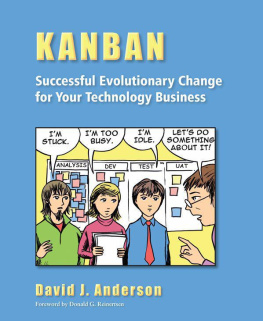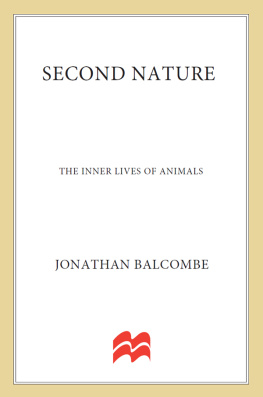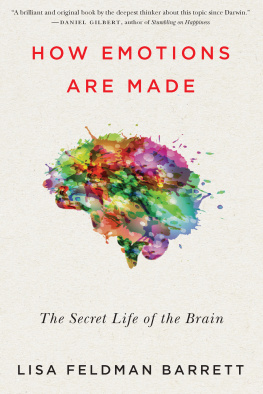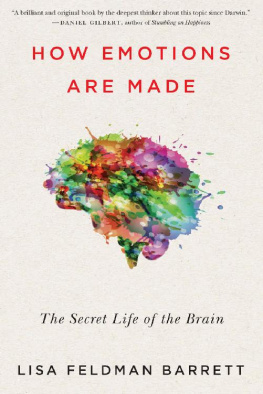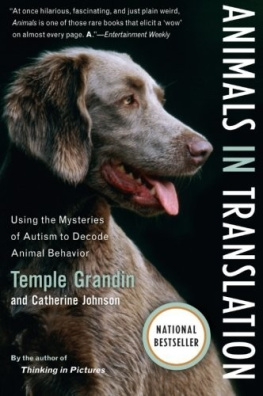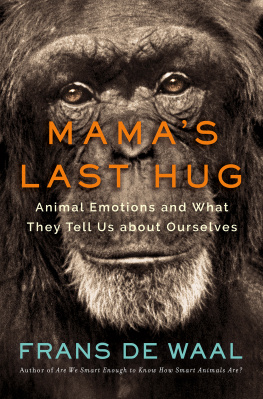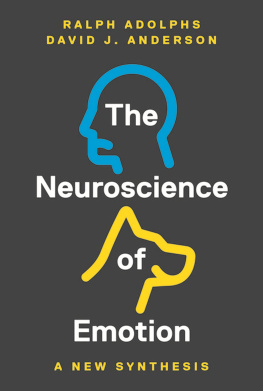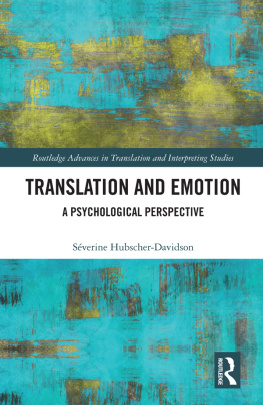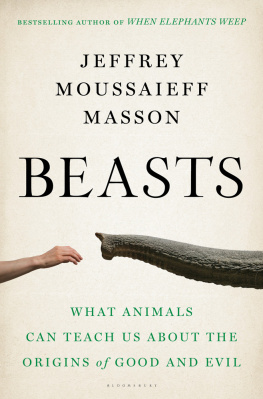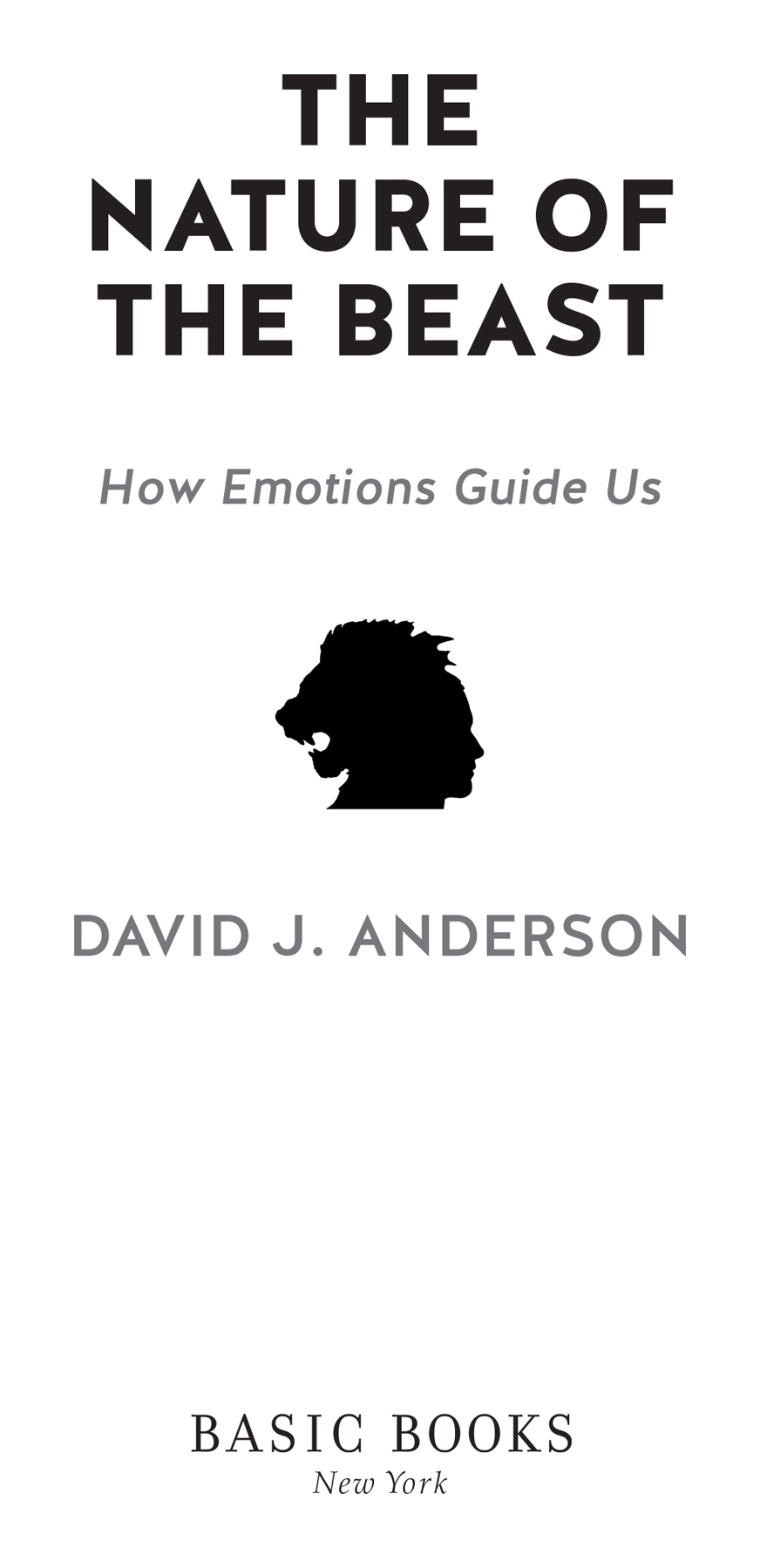
Copyright 2022 by David J. Anderson
Cover design by Ann Kirchner and Chin-Yee Lai
Cover images Kaimook Studio 99/Shutterstock.com; Crattos/Shutterstock.com; Art Furnace/Shutterstock.com
Cover copyright 2022 by Hachette Book Group, Inc.
Hachette Book Group supports the right to free expression and the value of copyright. The purpose of copyright is to encourage writers and artists to produce the creative works that enrich our culture.
The scanning, uploading, and distribution of this book without permission is a theft of the authors intellectual property. If you would like permission to use material from the book (other than for review purposes), please contact permissions@hbgusa.com. Thank you for your support of the authors rights.
Basic Books
Hachette Book Group
1290 Avenue of the Americas, New York, NY 10104
www.basicbooks.com
First Edition: March 2022
Published by Basic Books, an imprint of Perseus Books, LLC, a subsidiary of Hachette Book Group, Inc. The Basic Books name and logo is a trademark of the Hachette Book Group.
The Hachette Speakers Bureau provides a wide range of authors for speaking events. To find out more, go to www.hachettespeakersbureau.com or call (866) 376-6591.
The publisher is not responsible for websites (or their content) that are not owned by the publisher.
Library of Congress Cataloging-in-Publication Data
Names: Anderson, David J., 1956 author.
Title: The nature of the beast : how emotions guide us / David J. Anderson.
Description: First edition. | New York : Basic Books, 2022. | Includes bibliographical references and index.
Identifiers: LCCN 2021034465 | ISBN 9781541674639 (hardcover) | ISBN 9781541674646 (ebook)
Subjects: LCSH: Emotions. | Affective neuroscience.
Classification: LCC BF511 .A47 2022 | DDC 152.4dc23
LC record available at https://lccn.loc.gov/2021034465
ISBNs: 9781541674639 (hardcover), 9781541674646 (ebook)
E3-20220112-JV-NF-ORI
For my parents, Jim and Helene,
who married science and the humanities
A CHILD PUMMELS A CLASSMATE IN A SCHOOL-YARD. Insults traded in a tavern escalate into a bar fight. Two rams butt horns on a mountain precipice. A pride of lionesses takes down a Cape buffalo. A malevolent mob storms the Capitol. A mass shooter slaughters scores of concertgoers from a hotel window.
All these examples are naked acts of aggression. They are overt behaviors that can be recognized and recorded in words or on video. However, at least in the case of humans, they are also accompanied by something we cannot see: an internal, subjective experience of emotion by the person committing the act. Witness any of the above situations, and you might assume that the assailants feel anger, rage, fury. But unless they specifically tell us how they feel, how can we ever really know what emotion they are experiencingor, indeed, if they are experiencing any emotion at all? And what about the experience of animals, whom we cannot even ask?
Clearly, there is some connection between aggressive behavior and things like anger and rage. It is difficult to imagine being driven to commit such violent acts without an underlying emotional drive. Yet our intuition and experience tell us that anger and aggression are not the same thing. After all, one can certainly feel angry without physically expressing that feeling as aggression. Is anger generated separately and independently from aggressive behavior in the brain, or are they different manifestations of the same process? Does anger cause aggression, does aggression cause anger, or is there no causal relationship between the two? Ultimately, these questions can only be attended to after weve answered a more fundamental one: What exactly are emotions, and what do they do for us?
The problem is that, despite centuries of inquiry on the topic, we dont know. Not only that, but scientists cannot even agree on what an answer should look like. There are easily half a dozen different perspectives people bring to the study of emotion: psychological, cognitive, sociological, anthropological, philosophical, and neuroscientific. Researchers in these disciplines dont speak the same language or understand things in the same terms. A psychologist seeks to explain emotions in terms of human drives, needs, and conflicts. A neuroscientist seeks to explain them in terms of patterns of brain activity. Some people want to explain a particular emotion, like sadness or fear; others want to understand in a general way what makes emotion different from other kinds of brain processes. Not only are we the proverbial blind men grasping different parts of the elephant and trying to describe what we are holding, but we dont even have the same word for elephant.
Given this intellectual diversity and lack of consensus, it is not surprising that there have been many books espousing new theories of emotion. Most of themcertainly most of the theories that make their way into the public conversationoriginate in psychology. Such theories are interesting and powerful, but they are often very abstract and hard to falsify by experiment. The perspective of this book is very different. I believe that neuroscience can offer us a way of thinking about emotions that is objective and empirical, and that gives us the tools to begin studying questions about emotion that have been so difficult that some have written them off as unsolvable.
But first, a little background. Neuroscientists study diverse animal species, including humans, to understand how the neurons and circuits within their brains give rise to internal drives and behavior. Neuroscientists use a variety of methods to measure and manipulate the activity of neurons in the brain. They also build computer models of brain function based on these data. This allows for an intricate, causal understanding of brain function at its most basic level. Neuroscience offers the hope that, when we understand the brain in sufficient detail, we will be able to explain how its activity gives rise to both behavior and emotion.
Perhaps you already agree with me about the value of neuroscience. Maybe you even believe I am behind the times and that this question has already been settled. For example, you may have read that fear is produced by activity in a brain structure called the amygdala. Arent there many studies in which neuroscientists put people in brain scanners and show that when theyre afraid, their amygdala lights up (that is, becomes more active)? If that is the case for fear, then surely something similar must also be true for anger. So isnt the only thing left to do to figure out where anger and rage live in the brain? Cant we just put people in brain scanners, have someone watch what happens in their brain when they get angry, and then repeat the same process for different emotions until we have mapped them all?
In a word, no. Brain-scanning experiments (technically known as functional magnetic resonance imaging, or fMRI) do not directly visualize electrical activity in the brain; rather, they image blood flow to a particular area. Consequently, they provide only a very coarse-grained view of brain activity. More important, such experiments only provide correlative data. If we observe activity somewhere in a persons brain while they say they are afraid or angry, we cannot know whether the brain activity is causing the emotion or the emotion is causing the brain activity. Furthermore, relying on what a subject says they are feelingthat is, verbal reportis not necessarily an accurate way to assess that persons subjective feelings. A subject can mischaracterize or even lie about what they feel. Whats more, it is quite difficult, in practice, to induce an authentic, bona fide emotion in a human subject in a brain scanner because the subjects know they are in an experiment and have all kinds of distractions, like the noise in the scanner and people running around in white lab coats. Finally, early fMRI studies of fear in different laboratories produced inconsistent results, as psychologist and author Lisa Feldman Barrett has shown (although more recent studies have produced more consistent results).


